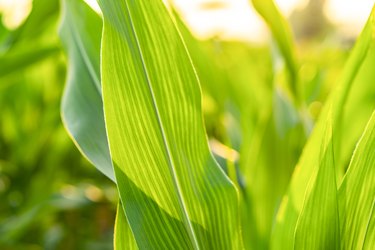
Sweet corn (Zea mays) is one of the best vegetables to grow in Florida, and few vegetables are as widely liked and as versatile as those golden ears. The state is mostly in USDA plant hardiness zones 8 to 10 (except for some of the Keys, which are in 11), broken into northern, central and southern regions. Temperatures in Florida usually don't dip below 10 to 40 degrees Fahrenheit, but you'll need to be more careful when growing it in the northernmost parts of the state.
When Is Florida Sweet Corn in Season?
Video of the Day
The central production region for sweet corn in Florida is in Palm Beach County, followed by Miami-Dade and Hendry counties. Much less is grown in Jackson and Suwannee counties, as the soil and temperature conditions aren't as ideal in this area. In Florida, sweet corn is in season from October through June, and most of it goes right to stores, farmers' markets and other vegetable sellers. Planting times vary depending on what part of the state you're in, and you can find charts that show this information.
Video of the Day
Corn needs a lot of bright sun and rich soil, and some of the best-loved seeds for planting include Silver Queen, Early Sunglow and the appropriately named How Sweet It Is. Another good one to try is Florida Stay Sweet corn seed. In the right conditions and with proper care, corn ears are ready to harvest about 60 to 90 days after the seeds are sown.
What Is the Best Time to Plant Corn in Florida?
The goal of planting and growing corn is to avoid temperatures that are too high or low. Corn will not thrive when the numbers reach below 40 degrees Fahrenheit or above 95 degrees. That's quite a range, but still, it's best to plant at the right time to minimize any risk. Plant the seeds from February through April if you are growing corn in northeast Florida. In central Florida, this time period expands to January through April. With southern Florida, things are different: Plant sweet corn seeds from October through March.
How to Plant Corn
Corn is a warm-weather crop, so you'll never want to plant it when the soil is below 60 degrees Fahrenheit. Corn gets pollinated by the wind, so it has to be planted in a certain way to grow and thrive. You can't just sow a few seeds in your garden and expect them to do well.
You can plant corn in a block or a circle instead of one long line. Sow the seeds 6 to 8 inches apart, making the rows 1 foot apart from one another. The plants need at least six to eight hours of sun daily, and they prefer soil that is rich in nitrogen. They also need a lot of water but take care to water the soil near the roots and not the foliage because this could be detrimental to pollination. Give them a drink every seven to 10 days unless the soil feels dry down to 1 inch and give your corn plants a decent amount of mulch to keep them growing.
If you have to thin out the plants, use garden shears instead of pulling off the excess sprouts. Also, remove any weeds that are invading the roots. If all goes well, you'll start seeing silky-looking hairs emerging from your corn plants; this is how those kernels get pollinated. When they start to turn brown, that means that harvesting time is approaching. Pull back a husk to see if the kernels are formed. If they are, pick the ear and cook it that same day, as same-day freshness is always best.